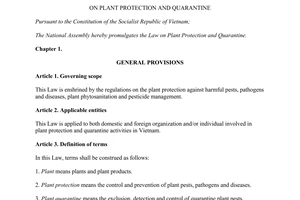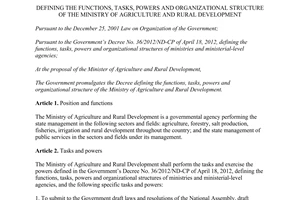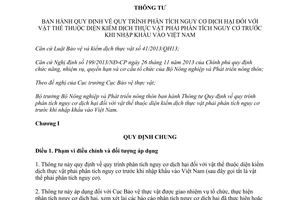Nội dung toàn văn Circular No. 36/2014/TT-BNNPTNT process of pest risk analysis before being imported to Vietnam
|
THE MINISTRY OF AGRICULTURE AND RURAL DEVELOPMENT |
SOCIALIST REPUBLIC OF VIETNAM |
|
Hanoi, October 31,2014 |
CIRCULAR
REGULATIONS ON PROCESS OF PEST RISK ANALYSIS FOR PLANT QUARANTINE TARGETS BEFORE BEING IMPORTED TO VIETNAM
Pursuant to the Law on Plant Protection and Quarantine No. 41/2013/QH13;
Pursuant to the Government’s Decree No. 199/2013/NĐ-CP dated November 26, 2013 defining the functions, tasks, entitlements and organizational structure of the Ministry of Agriculture and Rural Development;
At the request of Director General of Plant Protection Department;
The Minister of Agriculture and Rural Development promulgates the Circular regulating the process of pest risk analysis for plant quarantine targets before being imported to Vietnam.
Chapter I
GENERAL PROVISIONS
Article 1. Scope and regulated entities
1. This Circular regulates the process of pest risk analysis for plant quarantine targets before being imported to Vietnam (hereinafter referred to as the targets subject to risk analysis).
2. This Circular applies to Plant Protection Department assigned to conduct pest risk analysis, review reports on conducted pest risk analysis or assess risks of becoming weeds for the targets subject to risk analysis.
Article 2. Interpretation of terms
In this Circular, some terms are construed as follows:
1. Pest risk analysis zone means a country, part of a country, or whole or parts of countries that are officially recognized (hereinafter referred to as the zones).
2. Agro-ecological zone of Vietnam includes Northern mountainous midlands, Red River Delta, the North Central Coast, the South Central Coast, the Central Highlands, the Southeast and Mekong Delta.
3. Organisms running the risk of extinction mean species that belong to the list of wild animals and plants as prescribed in appendices of the Convention on international sale of wild animals and plants in danger enclosed with the Minister of Agriculture and Rural Development’s Circular No. 40/2013/TT-BNNPTNT dated September 05, 2013.
4. Penetration of a species of harmful organism means penetration of a species of harmful organism into an area where they have not been present before or present but in narrow scale and subject to strict control.
5. Introduction means penetration and establishment of colonies by a species of harmful organism.
6. Establishment of colonies means existence and growth of a species of harmful organism in an area in the near future after their penetration.
7. Goods contaminated with harmful organisms means presence of a species of harmful organisms of concern in goods; 8. Packages mean materials used for supporting, protection or carriage of goods;
9. Control of pest risk (for quarantine plant pest) means assessment and selection of measures to reduce the risks of penetration and spread of harmful organisms.
10. Plant quarantine measure means the measure taken to prevent introduction or spread of quarantine plant pest or reduce economic loss caused by targets subject to control.
11. Spread means expansion of geographical distribution of harmful organisms in an area.
12. Route of spreading means the way through which harmful organisms penetrate or spread.
13. Classification of harmful organisms means the process of determining if a species of harmful organism has characteristics of quarantine plant pests or targets subject to control.
Article 3. General provisions
1. For the targets subject to risk analysis, Plant Protection Department shall consider and decide to analyze the risks of becoming weeds before pest risk analysis is conducted according to this Circular;
2. Environmental risk analysis for imported useful organisms used in the protection of plants is conducted in accordance with National technical regulation.
3. Process of pest risk analysis includes three stages:
a) Kick-off state;
b) Assessment of pest risk;
c) Control of pest risk;
4. Reports on pest risk analysis must fully represent risk analysis result for imported plants. Manner and content of reports on risk analysis result must follow provisions set out in Appendix VI enclosed hereof.
5. Competent agencies for pest quarantine from exporting country shall be responsible for providing information in Vietnamese or English for pest risk analysis according to Form as prescribed in Appendix I (in case pest risk analysis is conducted on plants) or Appendix II (in case pest risk analysis is conducted on imported useful organisms used in the protection of plants) enclosed herewith; making registration with Plant Protection Department for conducting pest risk analysis on the targets subject to risk analysis.
Article 4. Budget
Annually, the state shall ensure provision of budgets for pest risk analysis on the targets subject to risk analysis.
Chapter II
PROCESS OF PEST RISK ANALYSIS
Article 5. Kick-off stage of pest risk analysis
1. Starting point of pest risk analysis
a) Determine path of spreading by which quarantine plant pests may be introduced and spread;
b) Determine harmful organisms pertaining to quarantine plant pests;
2. Pest risk analysis starts with the path of spreading.
Requirements for new or modified pest risk analysis shall start from the following situations:
a) A new type of goods or a type of goods of new origin expected to be imported to Vietnam;
b) A new species of plants to be imported for scientific research and selection of breeds;
c) Other paths of spreading: natural spread, packages, postal parcels, waste matters and luggage...;
d) Changes of regulations on plant quarantine or requirements for imported goods;
dd) New plant quarantine treatment methods or new information in need of consideration;
3. Pest risk analysis starts with species of harmful organisms.
Requirements for new or modified pest risk analysis start from the following situations:
a) Detect new species of harmful organisms already established in the zones under pest risk analysis;
b) Detect new species of harmful organisms contained in imported goods;
a) Species of harmful organisms run the risk of causing more harm in new zones than the zones under pest risk analysis and zones of origin;
d) Specific species of harmful organisms re-detected;
dd) A species of organisms imported for study, experimentation, teaching, trading or use as ornamental creatures;
e) New plant quarantine treatment methods or new information in need of consideration;
4. Formulate a list of harmful organisms likely to spread through imported goods; Then each species of harmful organisms on this list shall be transferred to stage 2 of the process of pest risk analysis; If quarantine plant pests are not detected in the path of spreading, pest risk analysis shall stop from here.
Article 6. Review of pest risk analysis result
1. Review reports on conducted pest risk analysis; If the pest risk analysis was adequately conducted before, the result thereof shall be used.
2. Review current conditions of the goods of the same type imported from other countries and having undergone pest risk analysis;
Article 7. Assessing the risk of becoming weeds
Assessment of the risk of becoming weeds that can be used for planting with respect to the targets subject to risk analysis is instructed in National technical regulations.
Article 8. Content of assessment of the risk of becoming weeds
1. Analyze figures on harmful organisms detected in quarantine plant targets of the same type imported to Vietnam: Compilation of figures on detection of harmful organisms contained in imported goods shall be carried out according to the forms as prescribed in Table 1, Appendix V enclosed hereof;
2. Classification of harmful organisms
a) Sources of information for the formulation of the list of harmful organisms for the targets subject to risk analysis include:
List and information on harmful organisms from exporting country and relevant requirements for information are prescribed in Appendix I enclosed hereof;
The list of harmful organisms detected in the targets subject to risk analysis shall be formulated according to the forms as prescribed in Table 1, Appendix III enclosed hereof;
Results of previous pest risk analysis;
Relevant international database;
b) Information used for classification of harmful organisms:
Geographic distribution (map of distribution, climatic zone);
Biological characteristics;
Manner of harm causing;
Path of spreading;
Harmful organism control measures currently used;
Other relevant information;
c) Result of classification of harmful organisms is established according to the forms as prescribed in Table 2, Appendix III enclosed hereof.
3. Determine if harmful organisms can become quarantine plant pests;
a) Criteria for determination:
Distribution in exporting country;
Possibility to be carried along on the targets subject to risk analysis;
Possibility to become quarantine plant pests;
b) Harmful organisms on the list as prescribed in Point c, Clause 2 of this Article that meet criteria as prescribed in Point a, Clause 3 of this Article shall be entered into the list of harmful organisms likely to become quarantine plant pests for further assessment according to the forms as prescribed in Table 3, Appendix III enclosed hereof.
4. Assessment of consequences of introduction
a) For each species of harmful organisms, consequences of introduction shall be assessed on the basis of five risk factors: relationship between harmful organisms and hosts and climate; host range; dispersibility; economic impacts; environmental impacts. The assessment shall be conducted in accordance with Appendix IV enclosed hereof.
b) Compilation of assessment results
Results of assessment are formulated according to the forms as prescribed in Table 4, Appendix III enclosed hereof.
5. Assessment of possibility of introduction
a) Introduction of each species of harmful organisms is assessed on the basis of six risk factors: quantity of the targets subject to risk analysis annually imported; post-treatment survival of harmful organisms; survival of harmful organisms during transportation; possibly undetectable harmful organisms at checkpoints; survival of harmful organisms in the area where the targets subject to risk analysis are transferred to; hosts facilitating growth of harmful organisms. The assessment shall be conducted in accordance with Appendix V enclosed hereof.
b) Compilation of assessment results
Results of assessment are formulated according to the forms as prescribed in Table 5, Appendix III enclosed hereof.
6. Conclusions on level of pest risk and requirements for plant quarantine measures for harmful organisms
a) Compilation of pest risk results for harmful organisms is formulated according to the forms as prescribed in Table 6, Appendix III enclosed hereof.
b) Depending on level of risk of each species of harmful organisms, following risk management measures shall be taken:
Low risks: Plant quarantine measures are not needed;
Medium risks: Plant quarantine measures are needed;
High risks: Plant quarantine measures must be tightly and specifically applied.
Article 9. Pest risk management
1. Management measures
Based on results of risk analysis for the targets subject to risk analysis along with consultation with scientists, managers, manufacturers, and importers, the following specific requirements for risk management shall be put forward to minimize the risks:
a) Request the exporting country to take specific plant quarantine measures for the targets subject to risk analysis imported to Vietnam;
b) Agree with the exporting country about importation of the targets subject to risk analysis to Vietnam;
2. Management measures to minimize pest risks:
a) Ban importation of the targets subject to risk analysis from specific countries or territories;
b) Request presentation of plant quarantine permits for imports;
c) Conduct inspection at the exporting country;
d) Request plant quarantine measures to be taken at the exporting country;
dd) Request the targets subject to risk analysis that are produced in harmful organism disinfected zones;
e) Inspection and handling at checkpoints;
g) Post-importation plant quarantine;
h) Other measures;
3. Assessment of efficiency and impacts of management measures
Assessment of efficiency and impacts of management measures to minimize pest risks shall be conducted on the basis of following criteria:
a) Economy;
b) Environment;
c) Society;
d) Feasibility;
dd) Conformity with applicable regulations;
e) Time required for application of a new measure;
4. Selection of management measures
Based on the consideration of impacts and efficiency of management measures, make appropriate selection for each quarantine plant pest and propose plant quarantine measures for the targets subject to risk analysis imported;
5. Draft reports on pest risk analysis
a) Draft reports on pest risk analysis are made according to the forms as prescribed in Appendix VI enclosed hereof;
b) Organize collection of suggestions on draft reports on pest risk analysis;
6. Draft requirements for imported plant quarantine;
a) Draft requirements for imported plant quarantine are made according to the forms as prescribed in Appendix VII enclosed hereof;
b) Organize collection of suggestions on requirements for imported plant quarantine;
7. Complete reports on pest risk analysis and requirements for imported plant quarantine;
Chapter III
IMPLEMENTATION
Article 10. Responsibilities of Plant Protection Department
1. Build plans and organize the implementation of pest risk analysis as prescribed hereof;
2. Make written notifications about risk analysis results to competent agencies for plant quarantine from exporting countries and relevant organizations and individuals;
Article 11. Effect
This Circular takes effect since January 01, 2015;
Article 12. Implementation
Director general of Plant Protection Department, heads of relevant agencies, organizations and individuals shall be responsible for executing this Circular.
Difficulties that arise during the implementation of this Circular should be reported (by agencies, organizations, and individuals) to the Ministry of Agriculture and Rural Development (Plant Protection Department) for compilation and submission to the Minister for consideration and decision. /.
|
|
PP THE MINISTER |
APPENDIX I
NECESSARY INFORMATION FOR PEST RISK ANALYSIS
(promulgated together with Circular No. 36/2014/TT-BNNPTNT dated October 31,
2010 of the Minister of Agriculture and Rural development)
I. General requirements
The plant quarantine authority of the exporting country shall provide updated information (within the last 10 years prior to the sending date) including hard copies and soft copies for pest risk analysis.
II. Specific requirements
1. Full address of the plant quarantine authority of the exporting country (phone number, fax number, and email address of the person in charge of information provision).
2. Information about the objects required to undergo pest risk analysis before being export to Vietnam
2.1. Scientific name;
2.2. Taxonomic rank;
2.3. Common name;
2.4. Synonym;
2.5. Species or line;
2.6. Parts of the plant to be exported to Vietnam (fruit, seed, etc.);
2.7. Uses (propagation, consumption, processing);
2.8. Previous importing countries other than Vietnam);
2.9. Images of the object subject to plant quarantine.
3. Information about the farming area
3.1. Name of the area, state, province, or district;
3.2. Climate conditions (highest temperature, lowest temperature, annual average temperature and rainfall; wind speed);
3.3. Planting time and harvesting time (month);
3.4. Estimated export quantity (tonnes per year)
3.5. Map of the farming area.
4. Information about production and pest management
4.1. Specific pest monitoring and management program; certification procedures (investigation method, sampling method, etc.);
4.2. Products from pest-free area shall be certified by the plant quarantine authority of the exporting country;
4.3. Information about farming and harvesting.
5. Information about the pests related to the objects required to undergo pest risk analysis and carriers of pathogens (vectors)
|
Scientific name and other name |
Common name |
Order |
Family |
Infected part of plant |
Distribution |
Biological characteristics |
Preventive measures |
Reference |
|
Small spiders 1. |
|
|
|
|
|
|
|
|
|
Insects 1. |
|
|
|
|
|
|
|
|
|
Fungi 1. |
|
|
|
|
|
|
|
|
|
Bacteria 1. |
|
|
|
|
|
|
|
|
|
Virus 1. |
|
|
|
|
|
|
|
|
|
Nematode 1. |
|
|
|
|
|
|
|
|
|
Wild grass 1. |
|
|
|
|
|
|
|
|
|
Other pests 1. |
|
|
|
|
|
|
|
|
*Relevant information about each pest must be provided
6. Information about post-harvest management
6.1. Packaging method;
6.2. Inspection procedures;
6.3. Post-harvest processing measures to prevent infection of pests and effectiveness thereof;
6.4. Post-harvest preservation conditions and re-infection control;
6.5. Images of the objects subject to plant quarantine after being packaged and labeled and ready for export.
7. Applied plant quarantine certification procedures (inspection, sampling, additional declaration, etc.)
8. Information about means of transport and preservation conditions during transport
8.1. Means of transport;
8.2. Preservation conditions (temperature, humidity) during transport.
9. Results of pest risk analyses done in other countries
Pest risk analyses must be done in accordance with international instructions on plant quarantine measures, especially those on pest risk analysis.
------------------------------------------------------------------------------------------------------
This translation is made by LawSoft and
for reference purposes only. Its copyright is owned by LawSoft
and protected under Clause 2, Article 14 of the Law on Intellectual Property.Your comments are always welcomed


